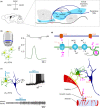Role of astrocytes in rhythmic motor activity
- PMID: 34558208
- PMCID: PMC8461027
- DOI: 10.14814/phy2.15029
Role of astrocytes in rhythmic motor activity
Abstract
Rhythmic motor activities such as breathing, locomotion, tremor, or mastication are organized by groups of interconnected neurons. Most synapses in the central nervous system are in close apposition with processes belonging to astrocytes. Neurotransmitters released from neurons bind to receptors expressed by astrocytes, activating a signaling pathway that leads to an increase in calcium concentration and the release of gliotransmitters that eventually modulate synaptic transmission. It is therefore likely that the activation of astrocytes impacts motor control. Here we review recent studies demonstrating that astrocytes inhibit, modulate, or trigger motor rhythmic behaviors.
© 2021 The Authors. Physiological Reports published by Wiley Periodicals LLC on behalf of The Physiological Society and the American Physiological Society.
Conflict of interest statement
No conflict of interest, financial, or otherwise, are declared by the authors.
Figures




References
-
- Acevedo, J., Santana‐Almansa, A., Matos‐Vergara, N., Marrero‐Cordero, L. R., Cabezas‐Bou, E., & Diaz‐Rios, M. (2016). Caffeine stimulates locomotor activity in the mammalian spinal cord via adenosine A1 receptor‐dopamine D1 receptor interaction and PKA‐dependent mechanisms. Neuropharmacology, 101, 490–505. 10.1016/j.neuropharm.2015.10.020 - DOI - PMC - PubMed
-
- Angelova, P. R., Kasymov, V., Christie, I., Sheikhbahaei, S., Turovsky, E., Marina, N., Korsak, A., Zwicker, J., Teschemacher, A. G., Ackland, G. L., Funk, G. D., Kasparov, S., Abramov, A. Y., & Gourine, A. V. (2015). Functional oxygen sensitivity of astrocytes. Journal of Neuroscience, 35, 10460–10473. - PMC - PubMed
Publication types
MeSH terms
LinkOut - more resources
Full Text Sources

